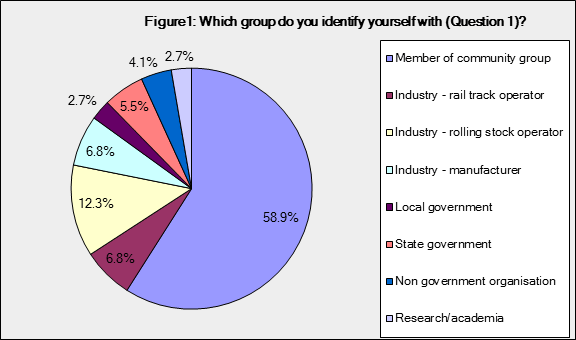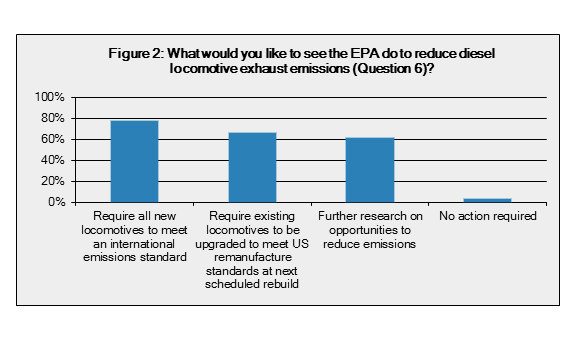Who did the survey?
The survey was completed by 84 respondents, most of whom were based in the Sydney metropolitan area (Questions 1–3). Respondents included
- community members
- industry representatives
- local and state government representatives
- representatives from non-government organisations
- stakeholders from research and academic institutions (Figure 1)
Community groups who completed the survey included
- Beecroft Cheltenham Civic Trust
- Correct Planning and Consultation for Mayfield Group
- Koolewong Tascott Point Clare Progress Association
- Pennant Hills District Civic Trust
- Residents Against Intermodal Development Moorebank
- Thirroul Village Committee

Figure 1 Which group do you identify yourself with (Question 1)?
Barriers to reducing emissions
In Question 4, respondents were asked what they believed were the main barriers to reducing locomotive exhaust emissions. Most stakeholders identified Australia's ageing fleet and ageing railway network as a key challenge.
For community members, key concerns also included
- a lack of government intervention and policy
- a lack of monitoring, compliance and enforcement mechanisms to target the worst performing locomotives
- excessive and unnecessary idling, particularly near residential areas
- water pollution and noise from locomotives (outside the scope of the workshop).
For industry, the main challenge was the cost of finding and fitting appropriate technology that targets air pollution without raising fuel costs.
Additional information needed to manage emissions (Question 5)
Respondents indicated the need for
- more monitoring
- comparison of locomotives with other vehicles and methods of transportation in Australia and internationally
- specific evidence of links between emissions and health effects
Community members felt that regulatory action was required now as there was already enough information to act.
Actions to manage emissions (Question 6)
Almost all respondents wanted the EPA to take some form of action to reduce diesel locomotive exhaust emissions (Figure 2):
- 77% want the EPA to require all new locomotives to meet an international emissions standard
- 66% want the EPA to require existing locomotives to be upgraded to meet US remanufacture standards at their next scheduled rebuild
- 61% want further research.

Figure 2: What would you like to see the EPA do to reduce diesel locomotive exhaust emissions (Question 6)?
Actions relevant stakeholders have taken to reduce exhaust emissions from diesel locomotives
When answering Question 7, most industry respondents indicated they had undertaken some activities to reduce emissions.
Rail track operators and rolling stock operators said they had
- introduced policies to purchase emissions certified locomotives
- upgraded engines to reduce emissions
- implemented company procedures for reporting and repairing excessive exhaust emissions
- implemented driver assistance systems.
Industry manufacturers had
- upgraded engines to reduce emissions
- implemented driver assistance systems
- made kits available and supported the testing of kits.
Community groups had
- undertaken political and community lobbying
- increased awareness of communities affected by emissions from locomotives persistently reported idling locomotives
Organisations doing more to manage exhaust emissions
In Question 8, respondents were asked whether their organisation would do more to manage exhaust emissions. Responses were mixed, except for industry manufacturers and rolling stock operators who all answered ‘yes’. All respondents who answered 'yes' were asked about steps they would consider (Question 9).
Of rolling stock operators
- about 50% said they would consider buying emission certified locomotives, and introducing company procedures for reporting and repairing exhaust systems producing excessive emissions
- nearly 70% would consider driver assistance systems
- about 40% would consider upgrading engines to reduce emissions when due for a major rebuild.
All track operators said they would consider upgrades to reduce emissions, and implementing procedures for reporting and repairing locomotives with excessive emissions.
Half the manufacturers said they would consider engine upgrades and driver assistance technology.
Most community representatives answered 'other' which included activities such as increased lobbying and onsite monitoring of emissions.
Environmental concerns
In Question 10, respondents ranked from 1 to 5 their environmental concerns associated with the rail network by importance. The highest rated concern was diesel air emissions with an average rating of 3.9, followed by
- noise and vibration (3.7)
- greenhouse gas emissions (2.8)
- other air emissions such as coal dust (2.8)
- water pollution (1.8)

